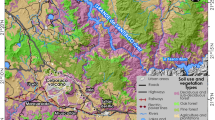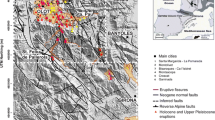Abstract
The San Martín shield volcano, located in the Los Tuxtlas Volcanic Field, has experienced effusive shield-building activity, as well as explosive eruptions, as evidenced by direct observations during the last eruption in 1793. The threat to the surrounding villages consists principally of lahars, especially because of the tropical climate in the region. Ash fallout and lava flows represent additional hazards. In addition, the surrounding Quaternary monogenetic field includes more than 300 scoria cones and about 40 explosion craters (mainly maars) that also represent a hazard source. In the present study we constructed hazard maps using field data, orthophotos, spatial analysis, and specialized software (LAHARZ and HAZMAP) to deliminate lahar inundation zones, areas that could potentially be affected by ash fallout (including the evaluation of houses prone to roof collapse due to ash load), and the most susceptible areas for hosting future monogenetic vent formation.












Similar content being viewed by others
References
Andreani L, Rangin C, Martínez-Reyes J, Le Roy C, Aranda-García M, Le Pichón X, Peterson-Rodríguez R (2008) The Neogene Veracruz fault: evidences for left-lateral slip along the southern Mexico block. Bull Soc Geol France 179:195–208
Blong R (1981) Some effects of tephra fall on buildings. In: Self S, Sparks RSJ (eds) Tephra studies. NATO Advanced Studies Institute Series, Reidel, pp 405–420
Blong R (2003) Building damage in Rabaul, Papua New Guinea, 1994. Bull Volcanol 65:43–54
Bonasia R, Capra L, Costa A, Macedonio G, Saucedo R (2011) Tephra fallout hazard assessment for a Plinian eruption scenario at Volcán de Colima (Mexico). J Volcanol Geotherm Res 203:12–22
Capra L, Norini G, Groppelli G, Macias JL, Arce JL (2008) Volcanic hazard zonation of the Nevado de Toluca Volcano, México. J Volcanol Geotherm Res 176:469–484
Connor CB, Brittain EH, Winfrey B, Franklin NM, La Femina PC (2001) Estimation of volcanic hazards from tephra fallout. Nat Haz Rev 2:33–42
Espíndola JM, Zamora-Camacho A, Godínez ML, Schaaf P, Rodríguez SR (2010) The 1793 eruption of San Martín Tuxtla volcano, Veracruz, Mexico. J Volcanol Geotherm Res 197:188–208. Continental Margin Volcanism—A volume in memory of James F. Luhr
Espíndola JM, Godínez ML, Zamora-Camacho A (2012) Volcanic hazard from San Martín Tuxtla Volcano, Tuxtla Volcanic Field, Veracruz, Mexico: probability maps of ash fall deposition from possible future eruption. Nat Haz 61:771–784
Ferrari L, Tagami T, Eguchi M, Orosco-Esquivel MT, Petrone CM, Jacobo-Albarrán J, López-Martínez M (2005) Geology, geochronology and tectonic setting of late Cenozoic volcanism along the southwestern Gulf of Mexico: the Eastern Alkaline Province revisited. J Volcanol Geotherm Res 146:284–306
Friedländer I, Sonder RA (1923) Über das Vulkangebiet von San Martín Tuxtla in Mexiko. Zeitschr Vulkan 7:162–187
García JA (1835) Eruptionen des Vulkanes Tustla in den Jahren 1664 und 1793. El Constitutional (Jalapa 8 Dic 1830). Neues Jahrbuch für Mineralogie 6:40–456
Gómez-Tuena A, Orozco-Esquivel MaT, Ferrari L, (2007) Igneous petrogenesis of the Trans-Mexican Volcanic Belt. In: Alaniz-Álvarez SA, Nieto-Samaniego ÁF (eds) Geology of México: celebrating the centenary of the geological society of México. Geol Soc Am Special Paper 422:129–181. doi:10.1130/2007.2422(05)
Iverson RM, Schilling SP, Vallance JW (1998) Objective delineation of areas at risk from inundation by lahars. Geol Soc Am Bull 110:972–984
Jaime-Riverón O, Pool C (2009) The impact of volcanic hazards on the ancient Olmec and Epi-Olmec economies in the Los Tuxtlas region, Veracruz, Mexico. In: Jones EC, Murphy AD (eds) In the political economy of hazards and disasters. Altamirano Press, Lanham, pp 133–154
Jennette D, Wawrzyniec T, Fouad K, Dunlap D, Meneses-Rocha J, Gmaldo F, Muñoz R, Barrera D, Williams-Rojas C, Escamilla-Herrera A (2003) Traps and turbidite reservoir characteristics from a complex and evolving tectonic setting, Veracruz basin, southeastern Mexico. AAPG Bull 87:1599–1622
Macedonio G, Costa A, Longo A (2005) A computer model for volcanic ash fallout and assessment of subsequent hazard. Comput Geosci 31:837–845
Martínez B, Milan M (1992) Análisis morfométrico de conos cineríticos en el Campo Volcánico Los Tuxtlas, Veracruz, México. In: Verma SP, Guevara M, Izquierdo MG, Santoyo E, Navarro-L I, Rodríguez de B CO, Barbarín CJM, Ramírez F (eds) Actas Fac Ciencias Tierra UANL Linares 7:237–242
Medel y Alvarado L (1963). Historia de San Andrés Tuxtla, Veracruz. Tomo I, prólogo de Leonardo Pasquel, México D.F. 274 p
Meneses de Gyves J (1953) Condiciones estratigráficas de los sedimentos Terciarios en la Cuenca de Veracruz. Bol As Mex Geol Petrol 5:105–112
Moziño JM (1870) Informe sobre la erupción del Volcán de San Martín Tuxtla (Veracruz) ocurrida en el año de 1793. Bol Soc Mex Geogr Estad 2:62–72
Nelson SA, González-Caver E (1992) Geology and K-Ar dating of the Tuxtla Volcanic Field, Veracruz, Mexico. Bull Volcanol 55:85–96
Pfeiffer T, Costa A, Macedonio G (2005) A model for the numerical simulation of tephra fall deposits. J Volcanol Geotherm Res 140:273–294
Pomonis A, Spence R, Baxter P (1999) Risk assessment of residential buildings for an eruption of Furnas Volcano, Sao Miguel, the Azores. J Volcanol Geotherm Res 92:107–131
Prost G, Aranda M (2001) Tectonics and hydrocarbon systems of the Veracruz Basin, Mexico. In: Bartolini C, Buffler RT, Cantú-Chapa A (eds) The western Gulf of Mexico Basin: tectonics, sedimentary basins, and petroleum systems. AAPG Memoir 75, 480 p
Reinhardt BK (1991) Volcanology of the younger volcanic sequence and volcanic hazards study of the Tuxtla Volcanic Field, Veracruz, Mexico, M.Sc. Thesis, Tulane University, 147 p
Rickenmann D (1999) Empirical relationships for debris flows. Nat Haz 19:47–77
Ríos-Mac-Beth F (1952) Estudio geológico de la región de Los Tuxtlas, Veracruz. Bol As Mex Geol Petrol 4:325–376
Rodríguez-Alvarado AF (2006) Los Tuxtlas: Nombres geográficos, Pipil, Náhuatl, Taíno y Popoluca. Ediciones Culturas Exclusivas 480 p
Santley RS (2007) The prehistory of the Tuxtlas. Univ New Mexico Press, Mexico
Schilling SP (1998) LAHARZ: GIS programs for automated mapping of Lahar-inundation hazard zones. US Geol Survey Open File Report 98-638, 80 p
Sheridan MF (1979) Emplacement of pyroclastic flows: a review. In: Chapin CE, Elston WE (eds) Ash-flow tuffs. Geol Soc Am Spec Paper 180:125–136
Smith GA, Fritz WJ (1989) Volcanic influences on terrestrial sedimentation. Geology 17:375–376
Smith GA, Lowe DR (1991) Lahars: volcano-hydrologic events and deposition in the debris flow-hyperconcentrated flow continuum. In: Fisher RV, Smith GA (eds) Sedimentation in volcanic settings. Soc Sed Geol, Spec Pub 45:60–70
Spence RJS, Kelman I, Baxter PJ, Zuccaro G, Petrazzuoli S (2005) Residential building and occupant vulnerability to tephra fall. Nat Haz Earth Sys Sci 5:477–494
Stuiver M, Reimer PJ (1986) A computer program for radiocarbon age calibration. Radiocarbon 28:980–1021
Acknowledgments
This study was developed as part of the project “Estudio Geológico del San Martín Tuxtla, Veracruz. Equipamiento, instrumentación y monitoreo con fines de prevención de desastres,” funded by GEV (Veracruz government) and FOPREDEN (Fondo de Prevención de Desastres). We thank the local Civil Protection for providing logistical support. We are very grateful to the reviewers, who helped to substantially improve the manuscript.
Author information
Authors and Affiliations
Corresponding author
Rights and permissions
About this article
Cite this article
Sieron, K., Capra, L. & Rodríguez-Elizararrás, S. Hazard assessment at San Martín volcano based on geological record, numerical modeling, and spatial analysis. Nat Hazards 70, 275–297 (2014). https://doi.org/10.1007/s11069-013-0807-7
Received:
Accepted:
Published:
Issue Date:
DOI: https://doi.org/10.1007/s11069-013-0807-7




